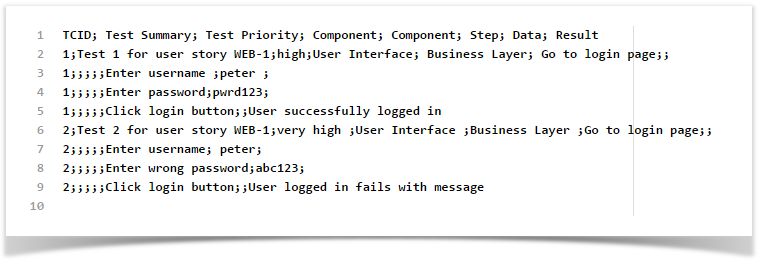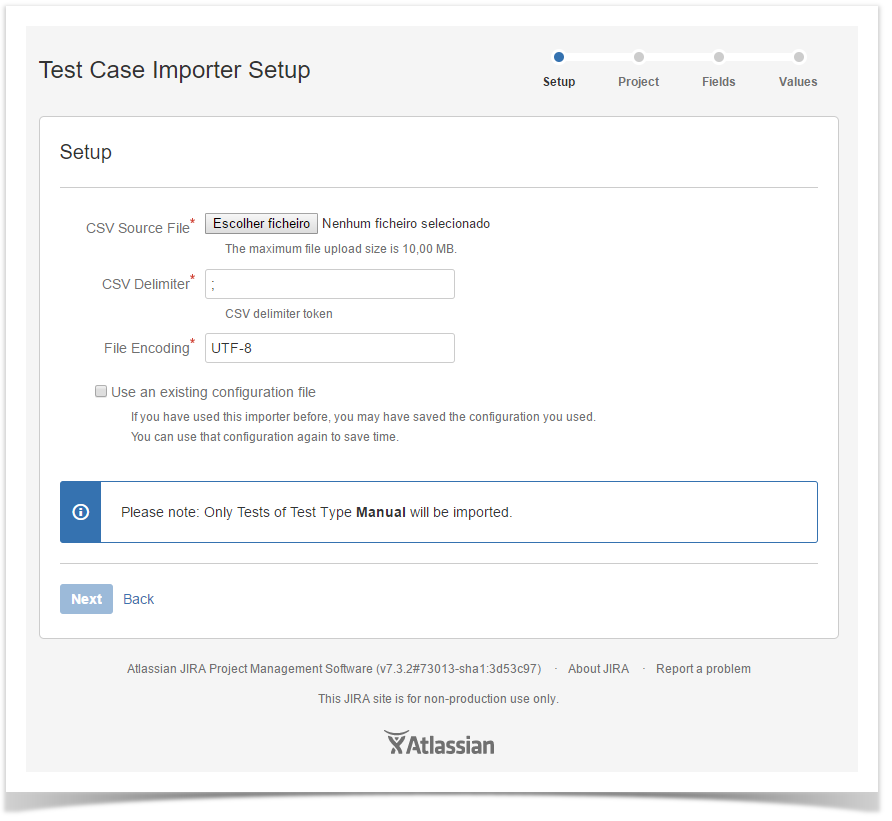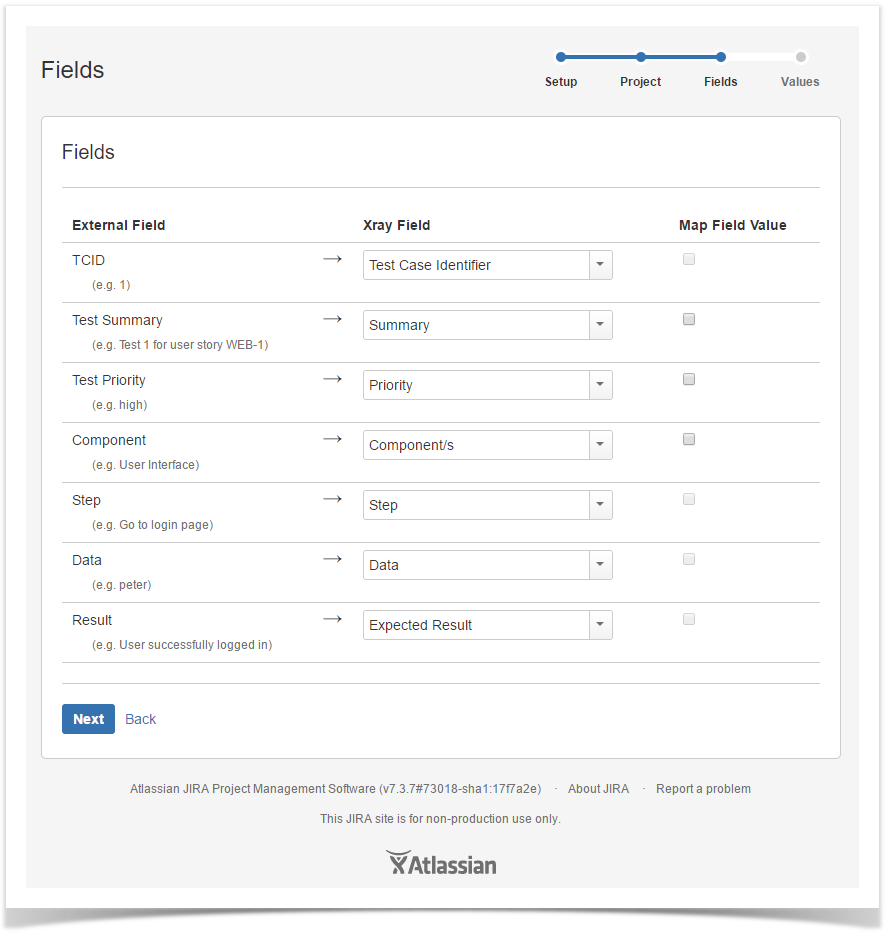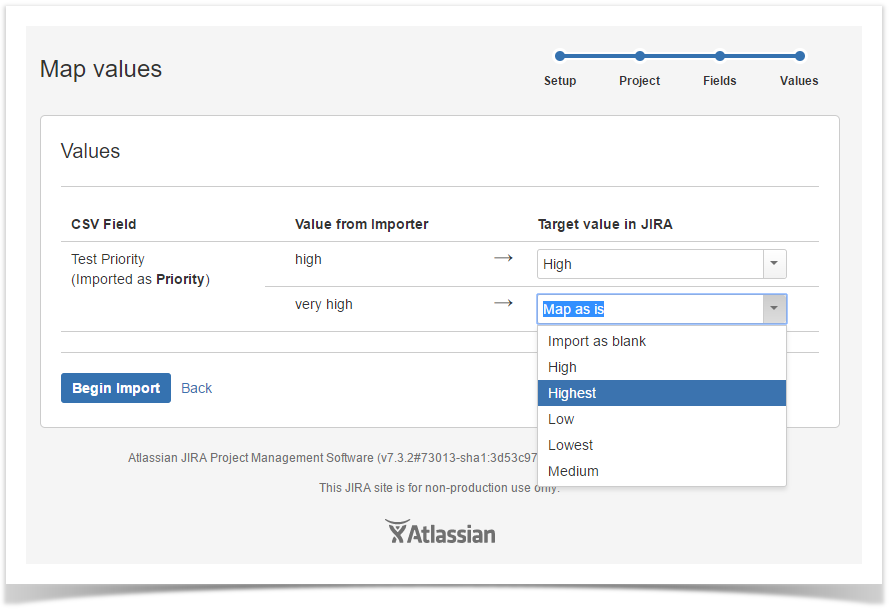You can use the Xray's Test Case Importer (a JIRA Importer Plugin extension) to import Manual Tests from a CSV source file.
Before importing
The CSV source file must follow some simple rules.
You can name the fields as you wish since they are going to be mapped during the importation process, but there are three mandatory fields:
- Test Case Identifier – this is the field used to identify which lines belongs to which test case. In the example bellow, it is the TCID column.
- Summary – this field is mandatory since JIRA doesn’t allow to create an issue without a summary. In the example bellow, it is the Test Summary column.
- Step – this field is going to be mapped as the Step field of a Manual Test Step. In the example bellow, it is the Step column.
Here is an example of test cases structure
And here is how the CSV file looks like once the test cases above are exported to CSV
CSV column separator
If you choose the “,” (comma) as the CSV columns separator, you must quote any field that contains commas.
Fields with line breaks
If you need to use new lines within a field, like in the issue description for example, you need to quote the field.
Importing Test Cases
For demonstration purpose, the CSV example file from the previous section is used.
To complete the importation process, follow the examples bellow.
- Log in with an administrator account
- go to System>Import and Export>External System Import
- Choose the Xray "Test Case Importer" like shown in the image bellow
Then the basic settings for the importation process must be provided.
- The CSV Delimiter field is where you provide the column delimiter used in your CSV source file.
- The File Encoding field is where you provide the encoding used in your CSV source file. Make sure that you provide the right encoding.
- Optionally you can use settings from a previous importation.
Next you need to select the Xray project where you want your Manual Test cases to be imported.
Next you need to map the fields from your CSV to JIRA and Xray fields
It is mandatory to map at least three fields:
- Test Case Identifier (located under Manual Test Step fields ). In this example this field is mapped with the TCID column from the CSV file.
- Summary (Located under JIRA fields ) In this example this field is mapped with the Test Summary column from the CSV file.
- Step (located under Manual Test Step fields ) In this example this field is mapped with the Step column from the CSV file.
The fields that aren't mapped will not be imported within the test case.
Custom field mapping
Only custom fields that have the issue type Test selected as one of the applicable issue types, will be available for mapping.
Available custom fields for import:
- Checkboxes
- Labels
- Number fields
- Radio buttons
- Select lists
- Text field
- URL field
- User picker
Note: Only single value custom fields are supported.
And in the last step, can Map the CSV column values. In the example above, the Map Field Value checkbox is selected for Priority, so next those values are going to be mapped.
Attachments
It is also possible attach files to Test and to Test Steps.
The attachment may be referred by name (in this case the file:// protocol is assumed), by "file://" or "http(s)://". Multiple files may be specified within one CSV column; for this, the attachments must be delimited by space.
Note: For file protocol, only files in the "<JIRA_DATA_HOME>/import/attachments" folder will be imported.
Links to requirements
Whenever importing Tests, it's also possible to specify the links to the requirements that each Test validates. For that purpose, columns must be mapped as Link "Tests".
If the Test covers multiple requirements, then multiple CSV columns must be used, each one being mapped in the same way.
Now just click next and Xray Test Case Importer will import the manual test cases to the selected project.
The importation process is complete. A configuration file can be saved to import other manual test cases using the same configuration.
For any questions regarding this feature, please contact our support team.
Useful tips
Importing data in any system may be a non-linear process and you may need to run it multiple times until you got the expected result, because simple things such as forgetting to map a field may happen.
Some general useful tips:
- add a unique label to all your tests, so you can clearly identify the tests imported at a given time; that will make your analysis simpler and eventualy if you do some bulk operation in them (e.g. change fields, remove them) it also be easier;
- use a custom field for storing the external ID of the tests in their original system. Thus, whenever tests are imported, you can easily compare them with the original ones in the original system;












